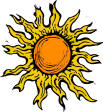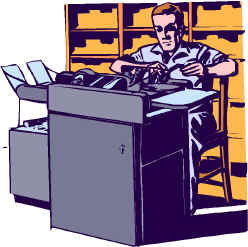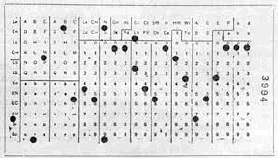
a perspective
| And pluck till time and times are done The silver apples of the moon, The golden apples of the sun. W. B. Yeats |

D.Vautier
updated 06-12
again 1-14
I spent a few years teaching computer history. The text books focused on what we like to refer to as "cool" or "neat" stuff such as binary code, bits, bytes, algorisms, etc. But much of this material did not emphasize how pioneers in the early 1890's and 1900's were suddenly confronted with unusually large amounts of data and were able to solve these problems in ingenious ways. Truly there was a lot of growth in the area of data processing during that time because of this sudden wave of increased population. Business had to become the world of the tabulation industry or the TAB world. In this environment a computer was unknown or considered a novelty or dream.
Data processing was a huge industry that did a lot of actual things and pretty much made the world go around. It was not driven by a bunch of weird math wizards who lived a dream life in a dream world. Data processing lived in the real world and dealt with large quantities of data and did wonderful things with that data long before the first bit or byte was ever thought of or dreamed of. Solid-state computers had very little to do with data processing before 1960, and were then only gradually and very cautiously accepted. Business computers began to grew out of a much larger and more stabilized framework, the unit record business, less glamorous, very boring and therefore far less recognized or even acknowledged today.
This is a brief exploration of the history of data processing as it truly was. The first "computers" were not electronic at all but consisted of a collection of ingenious and elaborate mechanical machines.
 Computer history
sometimes de-emphasizes this. Texts instead contain the more flashy material: Charles Babbage and his difference engine,
along with his likable
assistant Ada Lovelace, (who was considered the first programmer). I
don't know how that idea came about or how significant but it does
lend charm to an otherwise dull narrative.
Computer history
sometimes de-emphasizes this. Texts instead contain the more flashy material: Charles Babbage and his difference engine,
along with his likable
assistant Ada Lovelace, (who was considered the first programmer). I
don't know how that idea came about or how significant but it does
lend charm to an otherwise dull narrative.
 History
books also are sure to discuss the typical advances of the heavily
funded government ENIAC program during WW2, and the
more notable achievements of the blessed trinity, John Bardeen, Walter Brattain
& William Shockley, inventers of solid-state circuitry but these
inventions did not come anywhere close to immediately effecting business data processing.
Rather, they were
developments in
basic research which only later contributed to computer development.
History
books also are sure to discuss the typical advances of the heavily
funded government ENIAC program during WW2, and the
more notable achievements of the blessed trinity, John Bardeen, Walter Brattain
& William Shockley, inventers of solid-state circuitry but these
inventions did not come anywhere close to immediately effecting business data processing.
Rather, they were
developments in
basic research which only later contributed to computer development.
Missing from this accepted picture were some of the critically important but less attractive people below the surface realities that were not at all glamorous or showy or even particularly newsworthy, but beyond doubt played huge parts in the development of large data management. These realities laid the structure for all modern information systems. Computers were only a glitzy side show at first and only later replaced the mechanical tools.
 Processing more data faster has always been a big part
of industrialized growth, and being able to do it quickly with little error
was always the goal. What becomes an obvious fact is
that it doesn’t take a computer
to process large amounts of data.
Data
processing can be done and was done for a very long time by using plain everyday
mechanical devices consisting of wires, coils, solenoids, magnetos, magnets,
cardboard and electrical
switches, certainly not fast or flashy, but
done all the same and done quite accurately.
Processing more data faster has always been a big part
of industrialized growth, and being able to do it quickly with little error
was always the goal. What becomes an obvious fact is
that it doesn’t take a computer
to process large amounts of data.
Data
processing can be done and was done for a very long time by using plain everyday
mechanical devices consisting of wires, coils, solenoids, magnetos, magnets,
cardboard and electrical
switches, certainly not fast or flashy, but
done all the same and done quite accurately.
Imagine for a second that computers never came along at all and the internet never happened. What would we be like as a society. Probably OK. There would be more jobs, more boring work, more newspapers, more reading skills, perhaps less wall street crime, much more book reading, and our paychecks would continue to be printed and come just as they had since the advent of data processing around 1900. The stock market would continue to work, the government would continue to run, we would continue to be fed and clothed. We fought a world war with over 10 million men in arms and many support structures in place and we did all the paychecks, banking, inventory, transportation, supply and support without a single solitary computer.
All Modern computer data processing today is very much based on the groundwork developed by unit record technology. In fact Unit Record operations lasted a long time, well over 70 years starting about the beginning of the 1900s. There were no computers being used anywhere. None. There was no Babbage or Lovelace or Pascal. There was no binary code or polish notation, or bubble sorts. These things were not needed. It had already been figured out.
 Quite expectedly data processing started in a very physical way
with the idea of storing data in a more accessible form than just ledgers. The first practical system to store
and manipulate digital data was cards with little holes in them, not altogether a new concept.
The
introduction of a practical use of digital card files solved a big problem
in data
storage. The other problem of data
manipulation was solved by a number of ingenious machines. Such
storage systems
and processing machines started around 1890, many years before electronic computers
were in existence. Unlike the theoretical and whiz-bang exploits of
early pioneers in the field of bits and bytes and complex operations,
the early type of data storage was totally physical.
Quite expectedly data processing started in a very physical way
with the idea of storing data in a more accessible form than just ledgers. The first practical system to store
and manipulate digital data was cards with little holes in them, not altogether a new concept.
The
introduction of a practical use of digital card files solved a big problem
in data
storage. The other problem of data
manipulation was solved by a number of ingenious machines. Such
storage systems
and processing machines started around 1890, many years before electronic computers
were in existence. Unlike the theoretical and whiz-bang exploits of
early pioneers in the field of bits and bytes and complex operations,
the early type of data storage was totally physical.
Herman Hollerith started it all. He did not use esoteric calculations involving wheels and cogs and difference engines but instead employed a very practical way to capture and store data and produce usable results. His inventions were quickly used in businesses and government in a time when innovation was badly needed and the country was growing like mad.
 Hollerith worked for the Census Department during the
1880 census. He decided that he could develop a better way to collect,
store, summarize, and report census data rather than just doing it tediously
in hand recorded ledgers and adding machines.
He decided to design a
card that
contained little punched holes in predetermined spots. These
holes represented digital information which was electronically counted or tabulated by
a machine that he also
designed. The census of 1890 was completed in just three years, even
before the 1880 census was done.
Hollerith worked for the Census Department during the
1880 census. He decided that he could develop a better way to collect,
store, summarize, and report census data rather than just doing it tediously
in hand recorded ledgers and adding machines.
He decided to design a
card that
contained little punched holes in predetermined spots. These
holes represented digital information which was electronically counted or tabulated by
a machine that he also
designed. The census of 1890 was completed in just three years, even
before the 1880 census was done.
In 1896 Hollerith left the Census Department and struck out on his own, setting up a company that by 1924 become IBM.
As time went on data processing had to grow to keep up with demand. In it's subsequent evolution there were at least four discernable technological stages that occurred which were referred to by the industry as generations.
 The four generations of data processing
The four generations of data processing